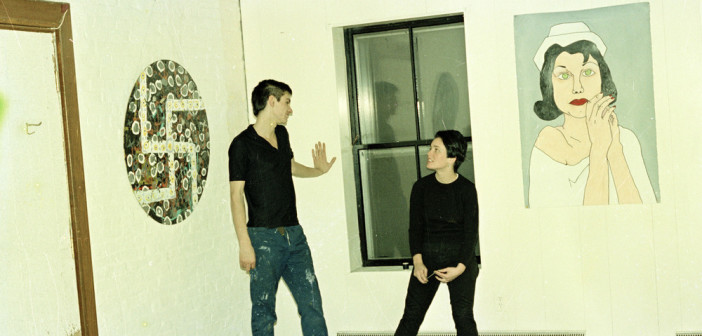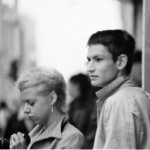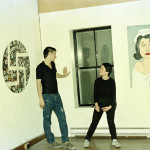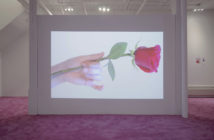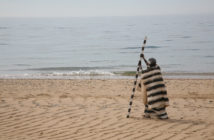The 11th Hour Gallery was cold. It was upstairs at 20 East Street, and in the very early 1980s, it was home to Mike Carroll and Penelope Place. Blocks away from South Station, on the outer edges of what was the Combat Zone until the mid 1970s, the 11th Hour was situated among parking lots and big businesses. Carroll and Place had found the space when they needed somewhere to make work for the Boston Film Video Archive. They weren’t supposed to be living there as it was a commercial building, and was thus heated only Monday through Friday, nine in the morning until five at night. It was after nine and before five that the 11th Hour was very awake, as Carroll and Place put on raucous performances by The Fucking Barbies, Steve Stain, Human Sexual Response and others, including the Clam Twins, the drag duo that were Taboo! (Stephen Tashjian) and Mark Morrisroe. They also put art on the walls—art that challenged the material of photography and the nature of performance, film and document.
The material and character of photography exploded in the 1970s, in the wake of such texts as Susan Sontag’s On Photography and technological innovations such as Polaroid. Boston was no different—the 1985 Boston Now: Photography exhibition, curated by David Joselit, Elisabeth Sussman and Gillian Levine, received a record 335 submissions.1 According to then ICA Director David Ross, Boston Now: Photography attempted to look at how photography changed art, and "reveals the Boston area as one of the nation’s strongest centers for photographic activity."2 Coincidentally, the late 1970s and early 1980s saw record high numbers of state dollars directed to arts funding in Boston. According to Rachel Rosenfield Lafo, in her essay to accompany the deCordova’s 2002 exhibition Painting in Boston: 1950-2000, the state funded $20 million towards the arts in 1987, and opportunities for artists increased accordingly.3 In her essay Photography in Boston, 1970-1985: Expansion and Experimentation, included in the catalogue for the deCordova’s 2000 exhibition Photography in Boston: 1955 to 1985, Lafo writes that the "role of public funding agencies in supporting photographic projects in the 1970s and early 1980s cannot be underestimated,"4 and yet some of the area and period’s most innovative and significant artists working with photography or video—David Armstrong, Nan Goldin, Mark Morrisroe, Gail Thacker, Jack Pierson—were decidedly and triumphantly outside the mainstream and middle American culture. Carroll, Morrisroe, Pierson and Thacker, along with Pat Hearn5 and musicians such as Steve Stain (who rented a raw space at 38 Thayer Street in the South End, then populated by Leather District factories) formed a nexus of the alternative.
Incubating their practice on society margins, the group was fueled by a punk spirit and sense that spontaneity and performance were inherent in art making. Soon, most would launch their work into the global art world. As young artists, the group that inhabited the 11th Hour and 38 Thayer were apathetic to the greater art scene, inventing their own spaces as opposed to inserting themselves in someone else’s.
"When I started putting art on the walls, there was this sense of urgency to do it that once you started to do it, it didn’t feel like urgency," says Carroll, who now owns and directs The Schoolhouse Gallery in Provincetown. "It wasn’t to get clients, it wasn’t to get into the scene, it was sort of like this family of people that made things, and the next thing to do was put them up."6 Stain was a drummer who often performed with Thacker, Hearn and Morrisroe, and hosted bands such as the Girls or Mission of Burma at 38 Thayer.7 The space was also a place to convene for impromptu performances, where invitees might be told to come wearing clown clothes or makeup.8 Though this group was on the periphery of the Boston art world, they were visible through their connection to pioneering video and photographic work, and through the music coming in and out of the city. "We felt that this is where we can be heard if we speak, we can be seen if we move, our colors are the colors of the times," says Carroll. "And it all came from that music. It all came from the fact that really good punk music was coming out of Boston, really good punk bands were coming to Boston."9
| Mark Morrisroe found his way to art by way of punk music, literally and figuratively. |
Morrisroe always alleged that the Boston Strangler was his real father. It’s true that Morrisroe and his mother, Patricia Morrisroe, lived next door to Albert De Salvo and he was their landlord in Malden, where Morrisroe was born. It’s also true that they share an uncanny resemblance. Morrisroe never knew his father, at any rate. Morrisroe also said that his mother was a prostitute, but according to Teresa Gruber, that rumor cannot be verified, though Patricia Morrisroe is reported to have been a depressive alcoholic.10 She dated a lot, and it was one of her boyfriends, Mitch, a manager at the punk club the Rat and arguably Morrisroe’s only father-like figure, who introduced young Mark to art. "Mark posed as a white trash angel of art, with no family support or influence, and he pretty much was right," writes Pia Schachter, a Museum School friend and classmate in her essay Mark’s Dirt: One Dame’s Take on Mark Morrisroe.11
In high school, with his childhood friend Lynelle White, Morrisroe haunted clubs such as the Rat. He and White wrote and published (via Xerox) Dirt magazine, a crude fanzine that featured scene gossip spun into myth. Morrisroe was queer, and also began prostituting himself in high school in an effort to move away from his mother and graduate. A client shot Morrisroe in 1976, severely hurting and forever maiming him with a crippled walk. He finished high school and received a grant to study at the Museum School, where he was promptly met with disdain and even disgust from the faculty. Required to make work that demonstrated his proficiency with all media and technique, Morrisroe made a gigantic wall of swastikas, each one created in a different material and style. Most of the faculty was appalled, but Jeff Hudson (who created the video program at the Museum School in 1974 with his wife, Jane) defended him. "I fought for him," says Hudson, when other faculty members wanted to expel Morrisroe.12 Jeff and Jane Hudson were young, just a few years older than Morrisroe, and they often played in bands with him and Pat Hearn. The Hudsons also allowed non-Museum School students, such as Stain, into their classes.13 In the late 1970s, the Hudsons were part of the Rentals, a punk trio formed in Boston; by 1982 they were the electro-punk duo Jeff and Jane and released their iconic Flesh album with a photo taken by Mark Morrisroe of Malcolm Travis, drummer of Human Sexual Response, in the shower. They also had a gallery, The Atlantic, on Atlantic Avenue, not far from the 11th Hour, which showed works by a then nascent Goldin, among others. "I couldn’t sell a Nan Goldin then, not for $100," says Hudson.14
According to Morrisroe’s last boyfriend, Ramsey McPhillips, it was Goldin who taught Morrisroe his way around the Museum School darkroom, and whose early success with The Ballad of Sexual Dependency became a metric for artistic achievement and fame.15 However, McPhillps writes, Morrisroe thought that "her vision, which he called ‘vital,’ would have been better served in writing. He disagreed with those who found Nan’s work raw, candid, and impromptu…He believed that the complicated subtext of her work, the full ‘scope’ of her life behind the photos, was where her genius ruminated."16 Goldin took highly saturated snapshots of Morrisroe and their friends around their Hemenway Hotel apartments, often dressing up, hamming up, and generally performing as themselves for her camera. Morrisroe quickly mastered darkroom practice, and also made hundreds of Polaroids, cyanotypes, gum prints and c-prints. Polaroid work forms the bulk of Morrisroe’s estate, now deposited at the Fotomuseum Winterthur. Gruber, who took over organizing the estate in 2008, writes that Morrisroe first acquired a Polaroid 195 Land camera and film in 1979, through the Polaroid Corporation’s Artist Support Program.17 From then on he used the medium to make highly sexual, idealized head-on self-portraits, as well as ephemeral shots of his life and times around the Hemenway. Gruber writes that "T-665 Polaroid film became his preferred medium, because development of the black-and-white instant image could be manipulated well, and the negative produced incidentally could be used afterward for gelatin silver prints."18 Morrisroe took his Polaroid camera to the clubs, photographing punk bands and their spectators with a raw candidness. These stark, smooth images of punk bands are eerily dated to look at now—the spiked hair, make-up and destructive action of these Polaroids have an inherent immediacy, but feel now relegated to the realms of cultural pastiche. Manipulating the surface or negative of a Polaroid (or inscribing memories in the film’s trademark margins) became something of a Morrisroe signature. Scribbling droll writings in a sort of sarcastic nostalgic cant, Morrisroe edited and updated these works, imbuing a memorializing quality that was as immediate as it was historicizing. Morrisroe also invented a process in which he made "sandwich prints," by copying a color negative onto black and white film, and then taking the positive print and copying it again into a negative in order to cut it out and fix it to the color negative and exposing it again. The results are velvety flush works, often retouched with color and notable for a painterly Pictorialism, an aesthetic that confronted the boundaries of painting. These sandwich prints constitute a vast portion of Morrisroe’s entire artistic output, and the scientific method of matching and superimposing snapshot onto studied photograph and vice versa mimics the memory revision thematically inherent in Goldin’s Ballad of Sexual Dependency.
Reconstituting reality into beauty always preoccupied Morissroe. "We had ideas, but we weren’t intellectual," says Gail Thacker, a close friend of Morrisroe’s.19 They met while studying at the Museum School, and living in the nearby Hemenway Hotel, which was something of an art school dorm. Thacker also studied at MIT’s Center for Advanced Visual Studies, and once took Morrisroe with her to classes there. Collaboration was a primary way to explore and comprehend the ideas that Morrisroe and Thacker had, a shared attitude that didn’t necessarily extend into each other’s aesthetics. Thacker and Morrisroe showed their work together in Blow Both Of Us at Pat Hearn’s loft in 1980. Like Morrisroe, Thacker often worked with Polaroid, and makes intensely diaristic work of her friends and life—often the figures in these works are taken crisply straight-on, but other times figures emerge or recede in soft, nuanced textures of the printing process. (Some of her work may be seen in the entrance of the Gene Frankel Theatre on Bond Street in New York.) Many of Thacker’s works emanate a haunted quality, and many have been edited through ripping and stitching, as if destroyed so it could be remade. "Mark was a romantic," Thacker says. "He loved beauty, and risk taking."20 Thacker explains that she risks her negatives as a way of symbolizing risk in the life she’s led, and says that Morrisroe did the same. "We felt that if you don’t live, and breathe in life, to its fullest, how can you create," she says.21
Morrisroe graduated from the Museum School in 1981. That fall, he put on his first solo show at the 11th Hour. A small showing of twenty gelatin silver prints, most of the photographs presented in Mark Morrisroe at the 11th Hour were expertly printed, unadorned by expressive or Impressionistic qualities (one was later accepted to the 1985 Boston Now show). These were intimate, quiet photographs of Morrisroe’s friends and lovers, mostly, whom he captured with an Arbus-like awareness of emotion and eccentricity. Perhaps the most powerful of these is a softly focused, tender photograph of Jack Pierson (then known as Jonathan). In the early 1980s, Pierson was Morrisroe’s boyfriend, and he was included in the 11th Hour show in the nude, as if just out of a hot shower, his head illuminated and casting a giant shadow on the bathroom door he is opening into the dark room, where we feel that Morrisroe is lying in wait for him. These photographs derive from the documentary photography tradition, but unlike straight photography, in these works, Morrisroe’s eye is un-mistakable, and ever present. They are diaristic, documenting and celebrating his particular experience and vision, which was cultivated on the far margins of the Boston, and by extension American, mainstream.
Many of the group that would have seen Mark Morrisroe at the 11th Hour left Boston shortly thereafter. Thacker moved out of the Hemenway Hotel and Boston, eventually making her way to New York, where she now lives and continues to make artwork. Steve Stain got in to a car crash and left Boston for the West Coast. Hearn went to Paris, then New York. Morrisroe went to Paris in the winter of 1982, but didn’t like it there. He returned to Boston for a few years, working, as many of the group had in school, at Restaurant 29 (still open at 29 Newbury Street, though under different ownership).22 By the mid-1980s Morrisroe—like Thacker, Hearn, Taboo! and Pierson—was in New York, contending with the international avant-garde and showing his work at Hearn’s downtown spaces, now more professionally than he had years before in her Boston loft. "The big shift for us, for a lot of us, was when Pat Hearn went to New York," says Carroll. "Soon after, there was a picture of her in Interview magazine, and was transformed, for the picture basically, but she had this entirely different look, she had sort taken on not a persona, but a relationship with persona and identity that was fiercely designed to engage with the world on its own terms."23 This particularizing of identity was developed out of an overwhelming desire to be seen and to see the world in an individual way.
Desire—and memorializing desire—is the crux of This Will Have Been: Art, Love and Politics in the 1980s, a major exhibition investigating art made after Feminism splintered in the late 1970s, and before Clinton took office in early 1993. Organized by Helen Molesworth of the ICA, This Will Have Been opens November 15 at the ICA/Boston. Judging by the catalogue, the exhibition offers a dense, gratifyingly complex way of looking at how desire (to be known, to know and to change how and what people know) informed not only the decade, but also a period molded through radical changes to the American sociopolitical landscape. Molesworth writes in the introduction to the catalogue that the art of the 1980s is "almost impossibly heterogeneous,"24 and that the exhibition is informed by the idea that
"more than any other twentieth-century decade, the 1980s enacts most fully the ramifications of feminism for art, theory, and politics…always coursing through the works chosen for this exhibition is a profound belief in the capacity of art objects—indeed, of culture in the broadest sense—to signify, enact, and enable these multifarious forms of desire."25
The exhibition promises to be a heady exploration through the radically diverse methods, themes and subjects that preoccupied artists in the American 1980s, and is divided into four sections, or, as Molesworth calls them, "problem-ideas." These are "The End is Near," which attempts to realize the immense feeling of a finality to recusancy that attended art and history in the 1980s; "Democracy," which probes the politics of mass media and the street as spaces for public intervention, as well the political significance of Central and South American artists in the period; "Gender Trouble" elucidates on Feminism’s plurality and the meaning of desire as an agent of difference and exploring particularity; and "Desire and Longing" takes a deeply affecting look at artists occupied appropriation as critique, coupled with the queer and gay visibility made necessary through the AIDS crisis. "In hindsight, appropriation also reveals the desire on the part of the artists (and viewers) for ideas, positions, and objects that supposedly lie outside of the intellectual arena of advanced art and ideas—desire for fame, greatness or success," writes Molesworth.26
Those desires mark and inform the work of Morrisroe and his circle of friends from the Museum School, who orbited around punk rock clubs, such as the Rat, and the alternative spaces such as the 11th Hour and 38 Thayer. But surprisingly, of this group only Nan Goldin is included in This Will Have Been, with no mention of how the alternative Boston scene shaped or participated in her work. Morrisroe is mentioned in the catalogue in very brief passing, for his work included in the New York Film Festival Downtown, and for having died of AIDS.
Morrisroe died in 1989, with a few close friends present, Gail Thacker among them. At the time, he was living in a Jersey City apartment, with views of the Statue of Liberty,27 close by to where Ronald Reagan had kicked off his 1980 presidential campaign. His life and work in the 1980s was contoured by the politics of art and society that Molesworth confronts in This Will Have Been, and yet she neglects to highlight or contextualize how those politics shaped the epoch in Boston. It is an oversight that Molesworth seems all too conscious of in the catalogue. "The show really, I hope, is not seen as any kind of definitive or defining exhibition," she recently said. "I never meant it to be that. I always offered it as a conversational gambit."28 Thus, in This Will Have Been, Molesworth provides a comprehensive, intricate framework through which we can begin to understand art from the 1980s. We should not use her structure as a canon, but as a way to propel us into the history of the Boston’s alternative and collective practices from the 1980s. Just as it was up to Carroll, Thacker and Morrisroe to generate their own cold, raw, anti-institutional spaces, it’s up to us to remember and historicize that practice into the global discussion.
- Steve Stain and Gail Thacker. Photos by Gail Thacker.
- Gail Thacker & Mark Morrisroe at a Parade 1980. Photos by Gail Thacker.
- Mark Morrisroe & Pat Hearn, Blow Both of Us Installation Image, Pat Hearn’s Loft, Nurse Painting by Gail Thacker Swastika by Mark Morrisroe. Photos by Gail Thacker.
[1]David A. Ross, "Forward," Boston Now: Photography. (Institute of Contemporary Art, Boston, exh. cat., July 3-September 1, 1985), n.p. Running for about ten years at the ICA, Boston Now were yearly exhibitions devoted to taking a pulse on art in Boston by medium.
[2]Ibid, n.p.
[3]Rachel Rosenfield Lafo, "The Boston Art Scene: A Community and Its Institutions," Painting in Boston: 1950-2000. (The MIT Press, Cambridge, Mass., and DeCordova Museum and Sculpture Garden, Lincoln, Mass., exh. cat., September 14, 2002-February 23, 2003), p. 40.
[4]Rachel Rosenfield Lafo, "Photography in Boston, 1970-1985: Expansion and Experimentation," Photography in Boston: 1955 to 1985. (The MIT Press, Cambridge, Mass., and DeCordova Museum and Sculpture Garden, Lincoln, Mass., exh. cat., September 16, 2000-January 21, 2001) p. 70.
[5]Hearn attended the Museum School with Gail Thacker, Mark Morrisroe and others, and worked with painting, video and performance. By the mid-1980s, Hearn was one of the most influential and important dealers in the New York Downtown scene, showing work by artists such as George Condo, Philip Taffe and Milan Kunc. The Pat Hearn Gallery was one of the first in the East Village and later was one of the founders what would become the Armory art show. Hearn died in 2000. See Dan Cameron’s essay in East Village USA, (New Museum of Contemporary Art, New York, exh. cat., December 9, 2004—March 19, 2005).
[6]Mike Carroll, interview with the author in Provincetown, Mass., August 21, 2012.
[7]Steve Stain, phone interview with the author, October 6, 2012.
[8]Gail Thacker, interview with the author in New York City, October 1, 2012.
[9]Carroll, interview with the author in Provincetown, Mass., August 21, 2012.
[10]Teresa Gruber, "Biography," Mark Morrisroe )Fotomuseum Winterthur, Winterthur, Switzerland, exh. cat., November 27, 2010-February 13, 2011) p. 443.
[11]Pia Schachter, "Mark’s Dirt: One Dame’s Take on Mark Morrisroe," in Boston School (Institute of Contemporary Art, Boston, exh. cat., edited by Lia Gangitano. October 18—December 31, 1995.) Boston School included a survey of the Morrisroe Estate, then retained by Pat Hearn and organized by her gallery. Curated by Gangitano and Milena Kalinovska (with significant curatorial input from Pat Hearn) this exhibition was the first to historicize the Boston School within global or New York contemporary art discourse, but erroneously placed Museum School graduates such as Philip-Lorca diCorcia and Shellburne Thurber within the same context with that of Hearn, Morrisroe and Pierson. diCorcia and Thurber later expressed that they weren’t apart of the group that circled the 11th Hour or 38 Thayer Street. Likewise, Gail Thacker, a key participant in the group, was not included in the show.
[12]Jeff Hudson, phone interview with the author, October 1, 2012.
[13]Stain, phone interview with the author, October 6, 2012.
[14]Hudson, phone interview with the author, October 1, 2012.
[15]Ramsey McPhillips, "Who Turned Out the Limelight? The Tragi-Comedy of Mark Morrisroe," in Loss Within Loss: Artists in the Age of AIDS, edited by Edmund White (University of Wisconsin Press, Madison, 2001) p. 105. McPhillips’s essay on Morrisroe is biographical and critical, and one of the most candid written accounts on Morrisroe’s life to date. McPhillips and Lia Gangitano are publishing Morrisroe’s ephemera and writings in Mark Morrisroe: Mark Dirt, a book forthcoming from Paper Chase Press.
[16]McPhillips, 106.
[17]Teresa Gruber, "Survey of the Estate," Mark Morrisroe (Fotomuseum Winterthur, Winterthur, Switzerland, 2010, exh. cat., November 27, 2010-February 13, 2011) p. 437.
[18]Gruber, 437.
[19]Gail Thacker, interview with the author in New York City, October 1, 2012.
[20]Thacker, interview with the author in New York City, October 1, 2012.
[21]Thacker, interview with the author in New York City, October 1, 2012.
[22]Gruber, 447.
[23]Carroll, interview with the author in Provincetown, Mass., August 21, 2012.
[24]Helen Molesworth, This Will Have Been: Art, Love and Politics in the 1980s (Museum of Contemporary Art Chicago in association with the Yale University Press, New Haven and London, 2012, exh. cat., at ICA/Boston November 15, 2012—January 27, 2013) p. 16.
[25]Molesworth, 16-17.
[26]Molesworth, 39.
[27]Thacker, interview with author in New York City, October 1, 2012.
[28]Greg Cook, "Futures Past," The Boston Phoenix, September 21, 2012

